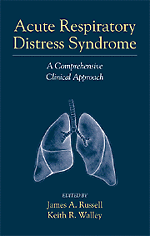Book contents
- Frontmatter
- Contributors
- Contents
- Preface
- Introduction
- 1 Overview, Clinical Evaluation, and Chest Radiology of ARDS
- 2 The Epidemiology of ARDS
- 3 The Pathology of ARDS
- 4 Cytokine -Induced Mechanisms of Acute Lung Injury Leading to ARDS
- 5 Pulmonary Pathophysiohgy in ARDS
- 6 Cardiovascular Management of ARDS
- 7 Mechanical Ventilation
- 8 Respiratory Muscles and Liberation from Mechanical Ventilation
- 9 Clinical Assessment and Total Patient Care
- 10 ARDS: Innovative Therapy
- 11 Nosocomial Pneumonia in ARDS
- 12 Resolution and Repair of Acute Lung Injury
- 13 Multiple System Organ Failure
- 14 Outcome and Long-Term Care of ARDS
- Index
14 - Outcome and Long-Term Care of ARDS
Published online by Cambridge University Press: 05 October 2010
- Frontmatter
- Contributors
- Contents
- Preface
- Introduction
- 1 Overview, Clinical Evaluation, and Chest Radiology of ARDS
- 2 The Epidemiology of ARDS
- 3 The Pathology of ARDS
- 4 Cytokine -Induced Mechanisms of Acute Lung Injury Leading to ARDS
- 5 Pulmonary Pathophysiohgy in ARDS
- 6 Cardiovascular Management of ARDS
- 7 Mechanical Ventilation
- 8 Respiratory Muscles and Liberation from Mechanical Ventilation
- 9 Clinical Assessment and Total Patient Care
- 10 ARDS: Innovative Therapy
- 11 Nosocomial Pneumonia in ARDS
- 12 Resolution and Repair of Acute Lung Injury
- 13 Multiple System Organ Failure
- 14 Outcome and Long-Term Care of ARDS
- Index
Summary
Introduction
A variety of treatments have been tried in patients with acute respiratory distress syndrome (ARDS) in an attempt to prevent, reverse, or diminish the inflammatory response that occurs in this setting. Although preliminary data with more recently studied interventions such as ketoconazole, surfactant replacement, and partial liquid ventilation seem promising, no approaches have yet been shown to alter survival, shorten the duration of ventilation or hospitalization, or reduce the frequency of ARDS-associated morbidity.
In lieu of data indicating a beneficial effect with any specific therapy, treatment of ARDS has focused on adjusting the fraction of inspired oxygen (FiO2) and positive end-expiratory pressure (PEEP) so as to reduce the likelihood of oxygen toxicity and/or barotrauma (recently, and appropriately renamed volutrauma). More recent observations indicating that much of the lung in patients with ARDS is not ventilated, along with the rediscovery that ventilation with high volumes actually causes lung injury, has led to the development of new ventilatory strategies designed to minimize this potential problem.
Although the more recent changes in supportive therapy of ARDS may not have been employed sufficiently long for differences in morbidity and/or mortality to become apparent, until just recently there was little evidence suggesting that the course of ARDS had been altered by any of these interventions. This chapter summarizes published information pertaining to the survival of patients with ARDS and how the episode of acute lung injury affects symptoms, roentgenographs, and pulmonary function. Aspects of appropriate management of patients after they are discharged from the ICU and from the hospital are also reviewed.
- Type
- Chapter
- Information
- Acute Respiratory Distress SyndromeA Comprehensive Clinical Approach, pp. 334 - 344Publisher: Cambridge University PressPrint publication year: 1999



